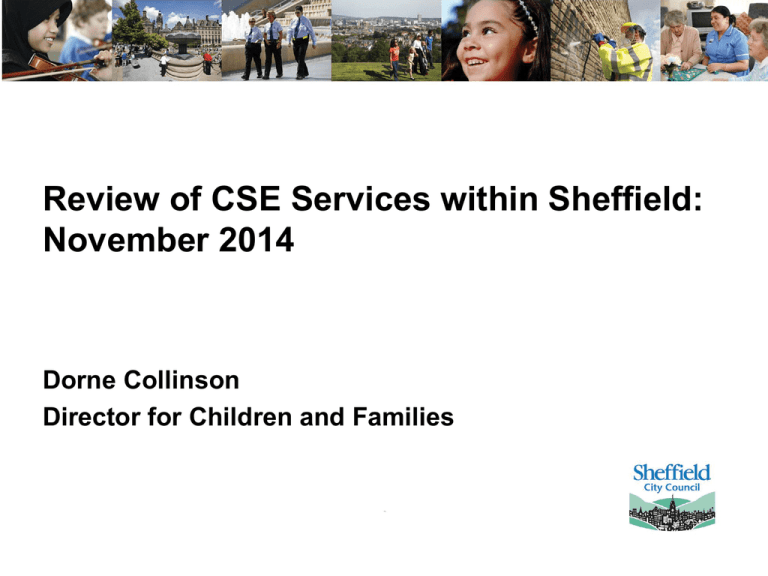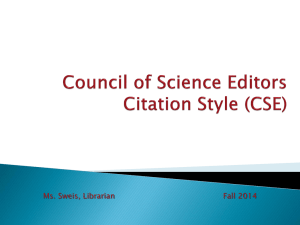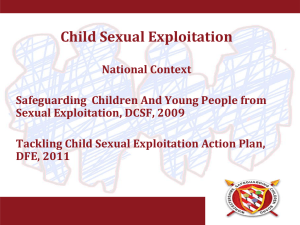Item 6 - Presentation - Child Sexual Exploitation
advertisement

Review of CSE Services within Sheffield: November 2014 Dorne Collinson Director for Children and Families Context • Agreed by Full Council and SSCB to conduct a review against the Jay Report findings and recommendations • Terms of reference agreed by the Chief Executive/DCS and partnership • Overview panel set up to scrutinise/challenge process • Transparent process, reporting back to Full Council, Children and Families Scrutiny and the SSCB Components of the review • Evaluation of leadership and governance arrangements • Review of policy and procedures, including annex A • Specific CSE Sec 11 audit • Staff survey • Training profiling • Case audits • Case examples • Capturing the view’s of young people Areas of strength (1) Strategy, leadership and compliance CSE is a long standing key strategic priority for SSCB and partners. SSCB and partners strongly comply with the Jay recommendations and many of the requirements have been embedded in Sheffield for many years, given the early and proactive response to CSE. Prevention; protecting; pursuing and prosecuting are at the heart of the CSE strategy. Sheffield has a history and evidence of being willing to tackle and confront difficult issues, regardless or any gender or ethnicity implications. SSCB and partners operate in a learning environment evaluating and adapting services to children and young people. Evolution of services and timely actions to address dynamic and complex demographics. Areas of strength (2) Quality assurance and recognition of the CSE Service Ofsted recognition of SSCB in effectively responding in partnership to CSE The SSES is long established and recognised as good practice by Ofsted and HMIC Areas of strength (3) Policy and Process SSCB and partners demonstrate good compliance with Ofsted’s CSE thematic inspection Annex A data and documentation requirements. The CSE self-assessment indicated that all agencies had a safeguarding lead, the majority also led on CSE. All agencies and many schools have a good understanding of the referral process for CSE cases. All agencies and schools have information-sharing protocols and actively encourage staff to attend multiagency meetings, contribute to and deliver the plan. Robust action had been taken to deal with CSE in all areas of licensing regulatory requirements. Areas of strength (4) CSE Awareness Programmes and Training CSE training and awareness programmes have reached over 1700 practitioners, is recognised as best practice and been adopted nationally. The voluntary, community and faith sector have been included in CSE training; planning and delivery. The impact of CSE training noted through increased referrals to SSES and participants’ acknowledgement of enhanced understanding. CSE awareness literature is available to children and young people; parents; carers and practitioners utilising innovative communication channels. SSCB and partners believe it is important to deliver CSE awareness to all of the community, regardless of gender or ethnic group. Areas of strength (5) Practitioner Activity Practitioners and managers are able to recognise the indicators of risk and vulnerability of CSE and when to refer children and young people to SSES. Practitioners requesting and undergoing continuous professional development to enhance their understanding of CSE and how to effectively support children and young people. Over 83% of practitioner respondents to the survey said they received enough support to respond to the issues of CSE. Over 94% of practitioner respondents said they were confident in identifying issues in relation to CSE. Case evaluations and audits demonstrated innovative and effective means on engaging with children and young people who have been subject to CSE. Areas of strength (6) Work with Children and Young People Work with children and young people around CSE spans across the spectrum of nationally-recognised thresholds from addressing need through universal services; Team around the child; Child in Need (CiN); Child Protection (CP) and at the far end of the need spectrum to children in care (LAC) at the most risk, including providing secure accommodation. Sheffield have a recognised Community Youth Model of working with the children and young people. Children and young people are involved in the development of CSE services through panels and one-to-one input. Sheffield children and young people also contribute to the consultation work of Office of the Children’s Commissioner. Future thematic panels are planned. CSE Assessment Areas for Development (1) Strategy, leadership and compliance SSCB need to continue to provide those who serve on scrutiny and licensing panels with sufficient CSE awareness and knowledge to enable effective independent challenge and decision making. SSCB need to ensure that all elected members, leaders and practitioners are aware of further CSE learning resources, including the National Working Group network. SSCB and SSES to co-ordinate a portfolio and timetable for reports and bulletins to inform relevant audiences including the SSCB Operational and Executive Boards; Scrutiny; agencies and schools, of CSE activity. CSE Assessment Areas for Development (2) Policy, process and systems Education advisors to provide a specific CSE policy for all schools and other groups such as MAST, faith sector and voluntary agencies, etc. Clearer pathway to, and greater availability of, health services for those children and young people who are impacted by CSE. Undertake a benchmark of investigation and prosecution statistics against other authorities. Further improve effective recording: CareFirst to be utilised as a central information system for recording all CSE activity taking place for individual children and young people. Access at appropriate levels to be provided to those working with children and young people. Rationalisation of information systems to reduce resource heavy data extraction for CSE profiling Record the ethnicity of all alleged offenders, to facilitate profiling CSE Assessment Areas for Development (3) CSE Awareness and Training SSCB and education advisors to provide a CSE training pathway for agencies and schools and to secure consistent high quality referrals. SSCB and SSES, together with partners, to further develop CSE awareness in schools and all communities within Sheffield including ethnic minority communities, leveraging on available networks and resources. Proactive availability of CSE awareness material in the main languages spoken in Sheffield to run alongside verbal messages. Guidance to be provided to practitioners on the relevant powers, duties and toolkits to aid engagement with 16/17 year olds who refuse to engage and parents who do not perceive risk. Next Steps Further Children and Young People’s Panels planned Additional actions arose from presentation of the report to Scrutiny and Cabinet CSE action plan developed Monitoring of implementation of action plan in SSCB and the CSE sub-groups Monitoring of implementation of action plan in Scrutiny reporting to Cabinet and Council Incorporating outcomes of current and future of government led CSE reviews, including the ongoing Home Secretary’s








